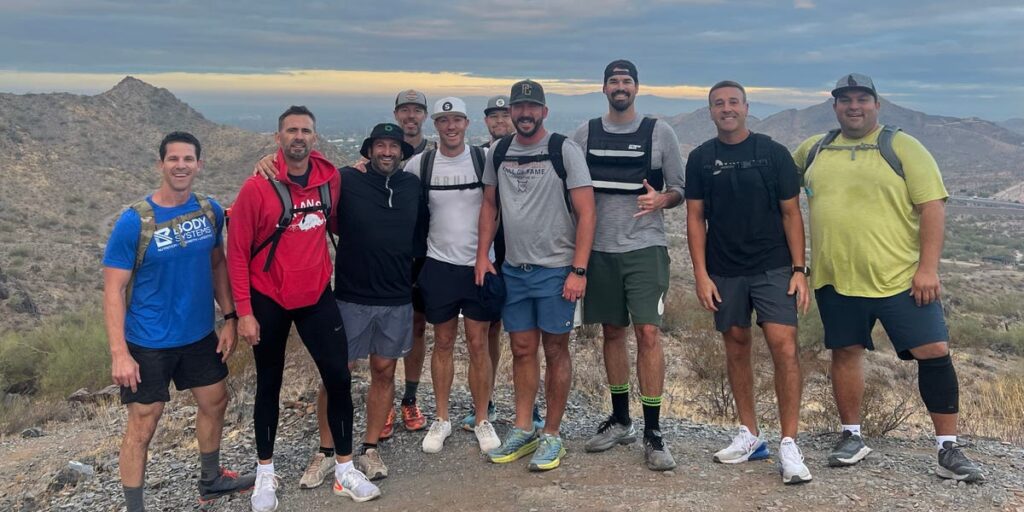- Rucking workouts are replacing traditional meetings for networking and business deals.
- The exercise can enhance the camaraderie of a group while helping people multitask and build fitness.
- A growing number of execs are taking up wellness trends like rucking to optimize health and performance.
Forget about a working lunch, grabbing a coffee, or hitting up a happy hour. These days, executives are throwing on a weighted backpack and trekking a few miles with colleagues and new contacts.
Rucking — walking while carrying weight, typically in a wearable pack — has skyrocketed in popularity in the fitness world as a way to enhance longevity, build muscle, and burn fat.
Now, the workout is replacing Zoom calls and desksides as the face-to-face activity of choice for sharing ideas, developing relationships, and creating career opportunities. Welcome to the era of the rucking meeting.
Former NFL player turned entrepreneur Jeff Byers told Business Insider he rucks on a treadmill desk during meetings and invites guests to join him in the exercise during one-on-ones.
Lee Heisman, an Atlanta-based entrepreneur and CEO of several businesses, including Exit Stage Left Advisors, has been rucking for years. For Heisman, the unique features of rucking make it an ideal activity for anyone willing to break a sweat, regardless of fitness level. As a networking tool, it can enhance connections while also fitting a workout into a buy schedule, he said.
“I don’t really have that much time or interest in sitting in front of someone at a desk or an office meeting and not doing something while we’re doing it,” Heisman said. “We’re going to have our meeting and we’re going to walk away feeling so invigorated. And it really helps your negotiation power when you’re working with someone, and they’re in a great mood.”
Health-conscious execs are redefining the work social
Wellness has already been seeping into the workplace.
Founders, investors, and venture capitalists are openly sharing the lifestyle tweaks they are making to be at the top of their game in business, from intermittent fasting to getting sober.
Casey Strunk, the president of Strunk Insurance Group in Phoenix, said he started taking his fitness and nutrition more seriously over the past few years, and conventional socials like boozy cocktail hours and rich restaurant meals weren’t always a good fit for his goals.
“I was still craving that sense of community with people that I enjoyed, that were leaders that helped level me up,” he told Business Insider.
He first learned about rucking about a year and a half ago at an entrepreneur conference featuring Michael Easter, a journalist whose books have driven a rucking renaissance.
Strunk heard a friend had begun a rucking network event and last fall, he launched his own local version called Rise & Ruck Phoenix.
Once a month, a hand-selected group is invited to meet up in a local park at 7 a.m. on a Friday for an hourlong ruck, followed by 30 minutes of coffee and conversation.
You need an inside connection to get an invite, and discussions often involve hot topics in the community across various fields from business to economics to medicine.
“We’ve been highly intentional. While it’s invite-only, we’re not exclusive. We’re inclusive of anybody that knows somebody who’s high performing in one aspect of their life” Strunk said.
Rucking is a natural fit for the ambitious multitasker, since it helps improve cardiovascular health, improves strength and stability, and burns fat all at once.
“For me, rucking was really about optimization,” Strunk said.
The networking appeal of rucking
Exercising at work isn’t only a convenient way to multitask on a busy schedule. It’s also strategic.
“When you have those endorphins kicking, how can it go wrong when you’re doing that type of exercise together?” Heisman said.
It can be humbling; getting in and out of the rucksack can feel like being a beetle stuck on its back, according to Heisman, and you risk looking out of breath if you go hard.
But rucking is fundamentally a scaleable exercise, making it relatively accessible. It can be adjusted for varying fitness levels by changing factors like the weight of the ruck, movement speed, and terrain.
Since everyone’s equipment is a backpack, it’s not about keeping up appearances; no one can compare weights the way you might visually do on a barbell.
“The beauty of the ruck is that there’s no egregious feeling of ‘You’re doing less than me or I’m doing more than you.’ It is so much more about ‘We’re doing this together'” Heisman said.
Heisman, a fan of ruck meetings for years said he puts a lot of thought into each meeting, often starting his guests out with lighter weight, offering them an option to add on the way back, and even planning the route so it ends on a hill. The overall effect is a sense of accomplishment and camaraderie that’s hard to replicate in an office.
For Strunk, the meditative monotony of rucking is what makes it so productive for a meeting. He and his associates have time to communicate and contemplate.
“I sure wouldn’t want to be in an F45 or Orange Theory group with other people where we were trying to communicate and network. But from a barrier-to-entry perspective, most people can walk for 60 minutes,” said Strunk.
Strunk’s group rucks end with the accoutrements of a good social, but he packs coffee with protein bars, shakes, and bananas to enjoy in a scenic park instead of pastries or donuts in a conference room.
Still, a bit of a challenge is part of what sets the ruck meeting apart. Getting your heart rate up prompts you to save your breath, cutting through the fluff: there’s no such thing as a ruck meeting that could have been an email.
“I think it lends itself for people to contribute in more meaningful ways when they have something to say rather than talking to talk,” Strunk said.
Read the full article here
















